Crepes
This post may contain affiliate links. Read my full disclosure policy.
Making traditional French crepes at home is easier than you think. Serve them up with your favorite sweet or savory fillings any time of day. Bon appétit!
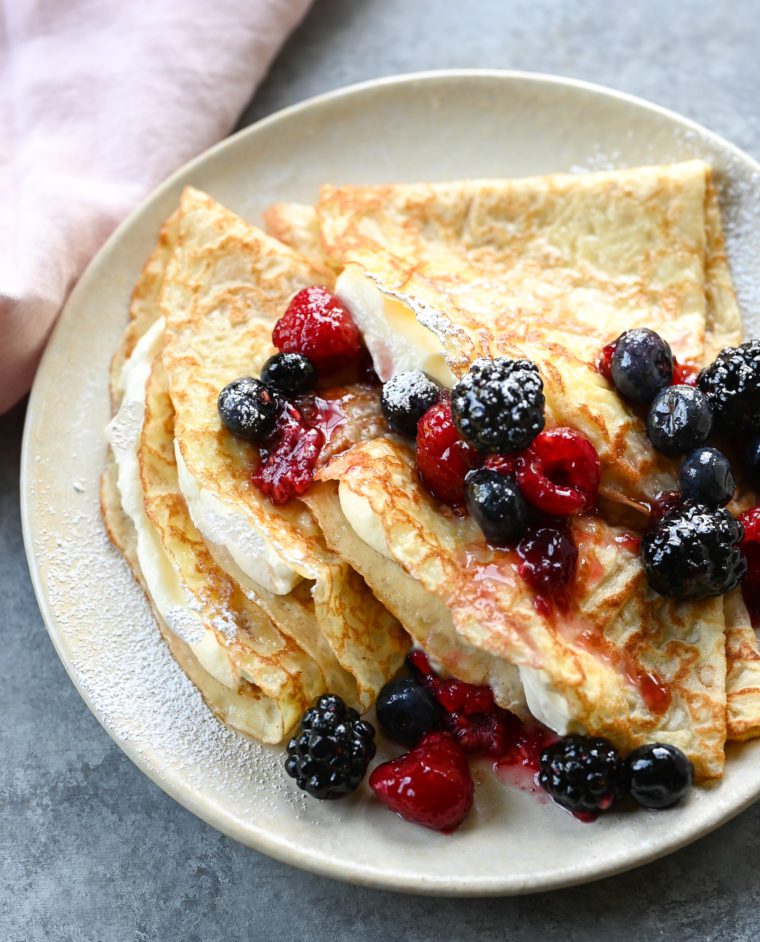
I trained at a French culinary school, but funny enough, that’s not where I learned to make crepes. That happened in Paris when I was working as an au pair for a family with three little boys who adored their crêpes au sucre and crêpes au Nutella. These thin, delicate pancakes, made with a simple batter of flour, eggs, melted butter, salt, and milk, are a staple French street food and incredibly easy to make at home. The batter comes together quickly in a blender, and each crepe cooks up in just about a minute.
The trickiest part is swirling the batter evenly around the pan before it sets, but once you get the hang of it, it’s a breeze. And don’t worry if the first one doesn’t turn out perfectly—the French have a saying, “la première crêpe est pour le chien” (the first crepe is for the dog). Crepes are wonderfully versatile, too—fill them with sweet or savory ingredients for breakfast, dinner, brunch, dessert, or even a snack. You can also make them ahead for a party and set up a crepe bar with all sorts of fillings. How’s that for easy and fun?
Table of Contents
“My first time making crepes and my whole family loved them. The kids enjoyed Nutella, strawberries and whipped cream and the grown ups had savory bacon and cheese.”
Common Crepe Fillings
For Sweet Crepes:
- Fruit and whipped cream, sweetened ricotta, Nutella, lemon curd, or chocolate sauce
- Butter and a sprinkling of sugar
- Lemon juice and a sprinkling of sugar
- Sautéed apples and cinnamon or applesauce
- Butter and fruit jam or preserves (my homemade fig jam would be wonderful)
- Peanut (or any other nut) butter and jam
- For a bit of texture, you can top off crepes with something crunchy (i.e., sliced almonds, candied pecans, granola, toasted coconut)
For Savory Crepes:
- Ham or prosciutto and cheese
- Chicken or turkey and mushrooms
- Spinach and cheese
- Smoked salmon and schmear (cream cheese)
- Ratatouille and goat cheese
- Sautéed or roasted veggies and cheese
- Scrambled eggs and cheese, with or without bacon
- Pesto sauce with chicken and greens
- Chicken or turkey with avocado
What You’ll Need To Make Crepes
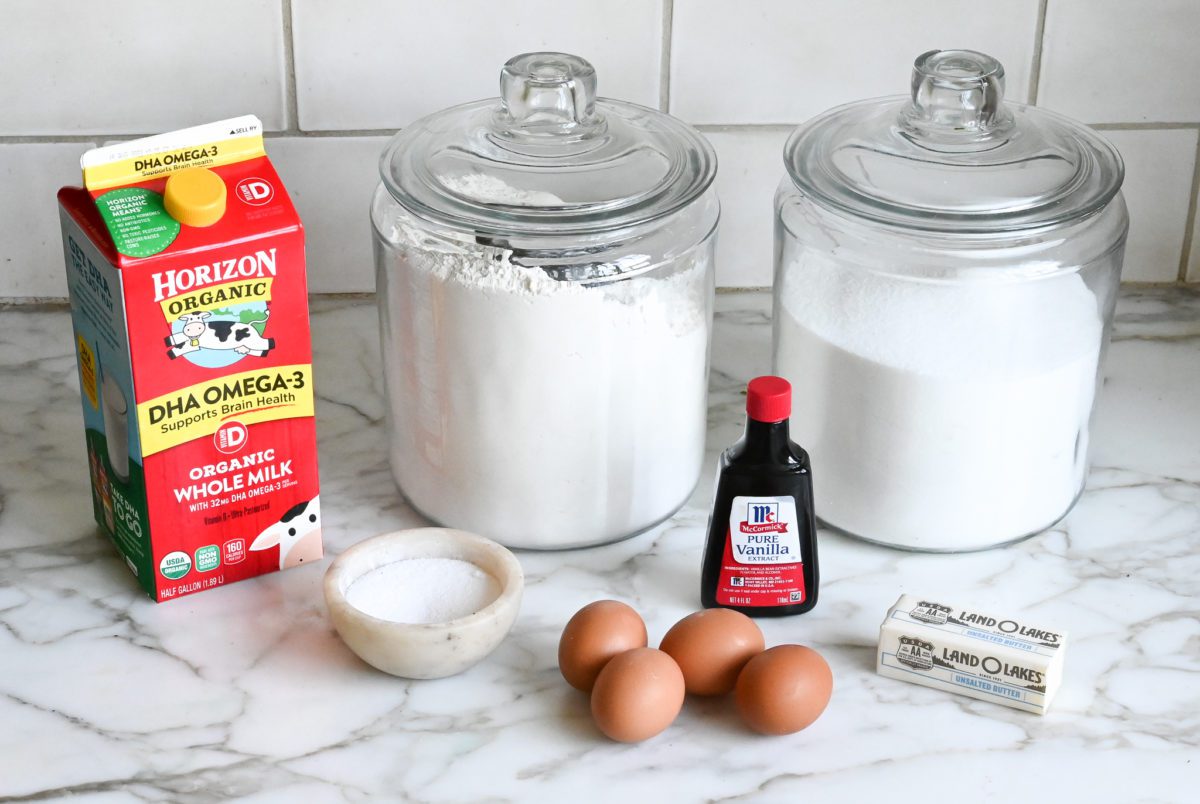
- Milk: Provides the liquid base for the batter. Whole milk makes the crepes richer, while 2% milk offers a slightly lighter option.
- Eggs: Bind the batter together, ensuring a delicate structure and contributing to the crepes’ tender texture.
- Sugar: Adds a hint of sweetness, complementing sweet fillings or toppings. For savory crepes, cut the sugar in half.
- Vanilla extract: Infuses the batter with a warm, aromatic depth, perfect for complementing sweet variations. Omit for savory variations.
- All-purpose flour: Provides the structure for the crepes.
- Butter: Used in the batter for richness and flavor, and also for greasing the pan to cook the crepes, giving them a lacy golden surface and slightly crispy edges.
- Jump to the printable recipe for precise measurements
Key Equipment
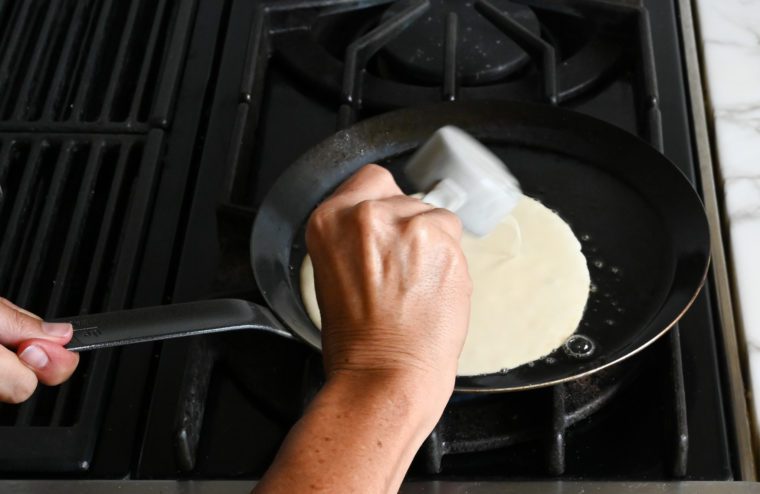
You can cook crepes in any 8 to 10-inch nonstick skillet (the base of the pan should have the same diameter that you want for your crepes), but the ideal pan is a traditional nonstick French crepe pan like the de Buyer blue steel crepe and tortilla pan pictured above. For pouring the correct amount of batter into the pan each time, I recommend using a 1/4-cup dry measuring cup with a long handle.
Step-by-Step Instructions
Step 1: Make the Batter
Place the milk, eggs, sugar, vanilla, and salt into a blender. Whiz for a few seconds to blend until smooth. Remove the lid and add the flour.
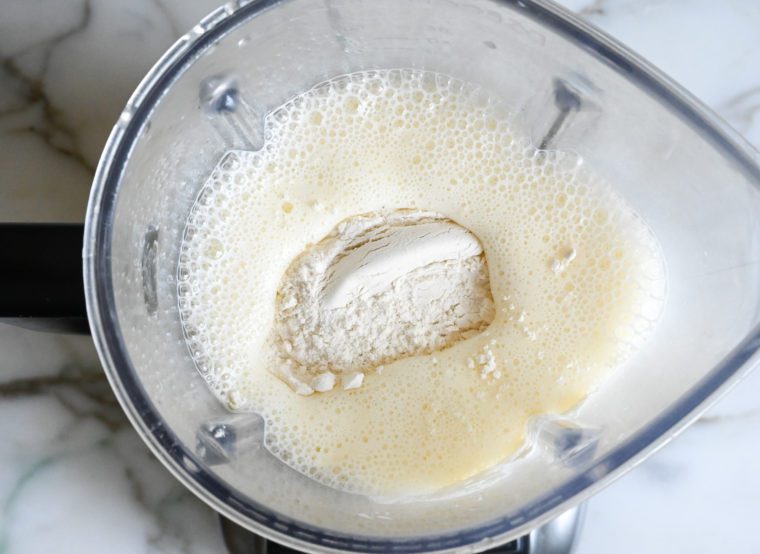
Cover and blend again until completely smooth, about 30 seconds. Remove the lid, pour in the melted butter, cover, and blend until combined, about 10 seconds more.
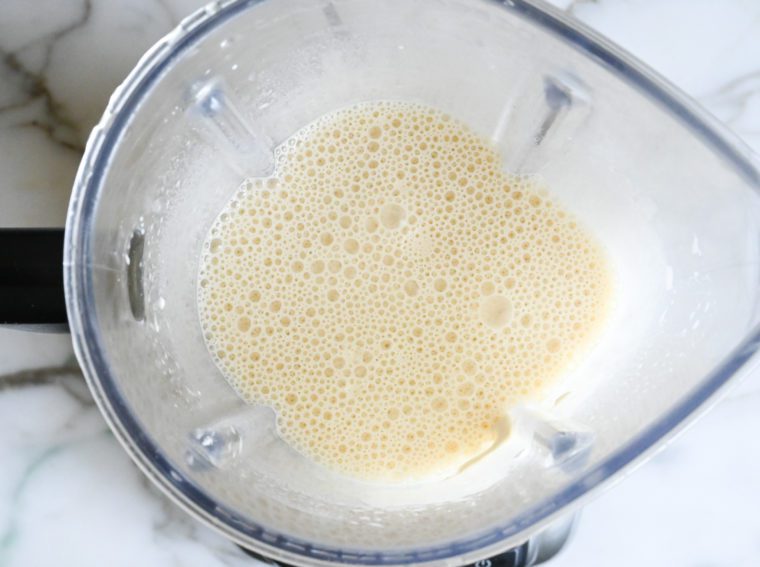
Step 2: Let the Batter Rest
Transfer the batter to a separate container and let it rest in the refrigerator for at least 30 minutes or up to 24 hours. Resting provides time for the flour to absorb the liquid and for the gluten to “relax,” resulting in delicate crepes that aren’t rubbery.
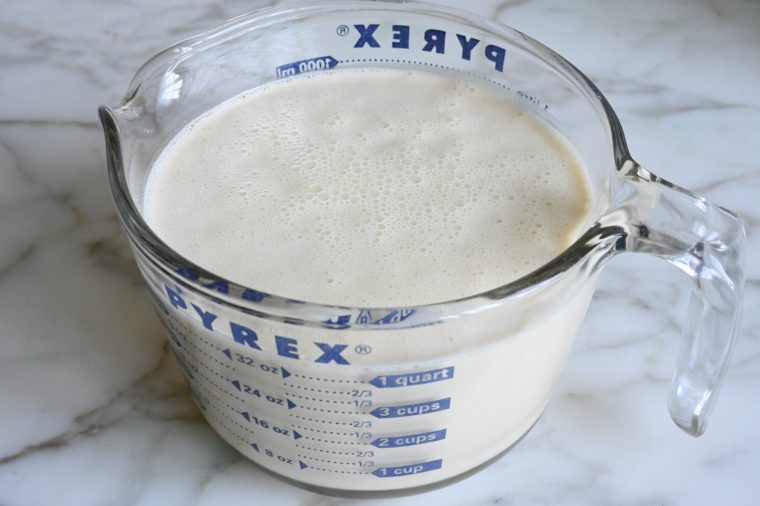
Step 3: Cook the Crepes
Heat a crepe pan or 8 to 10-inch nonstick skillet (see note) over medium heat. Grease the pan lightly and evenly with butter. Cooking the crepes in a little butter gives them a golden-brown, lacy surface.
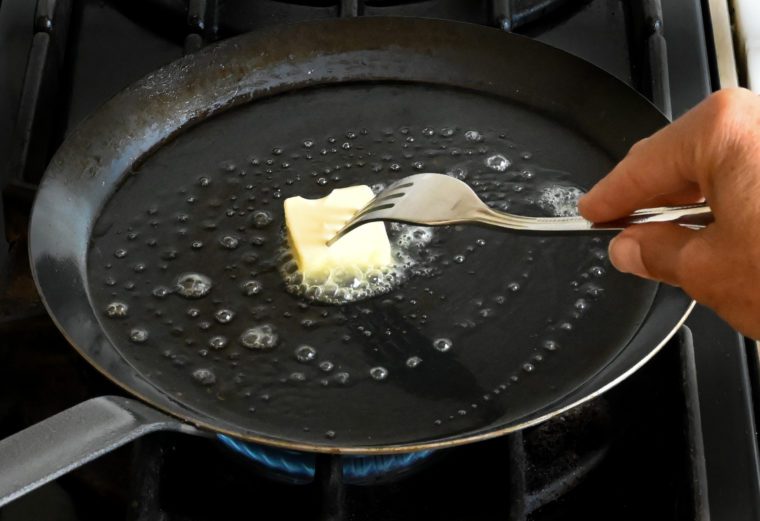
Pour about ¼ cup of batter into the center of the pan.
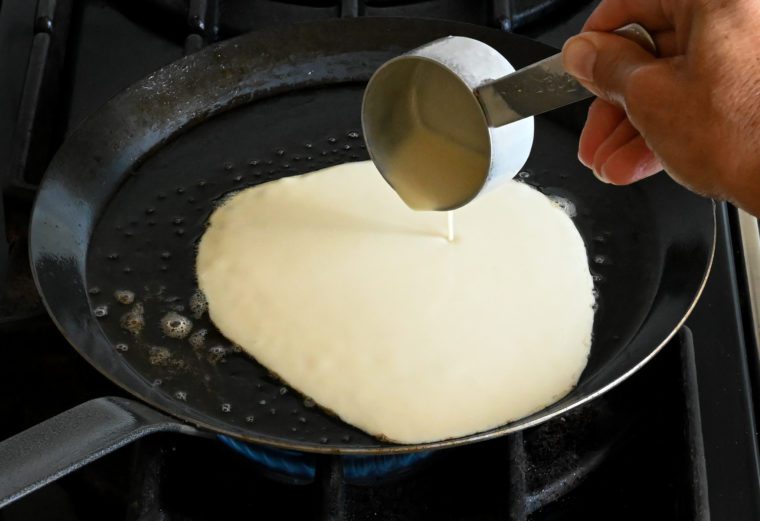
Immediately lift the pan off the heat and swirl the batter so that it forms a thin, even circle on the bottom of the pan.
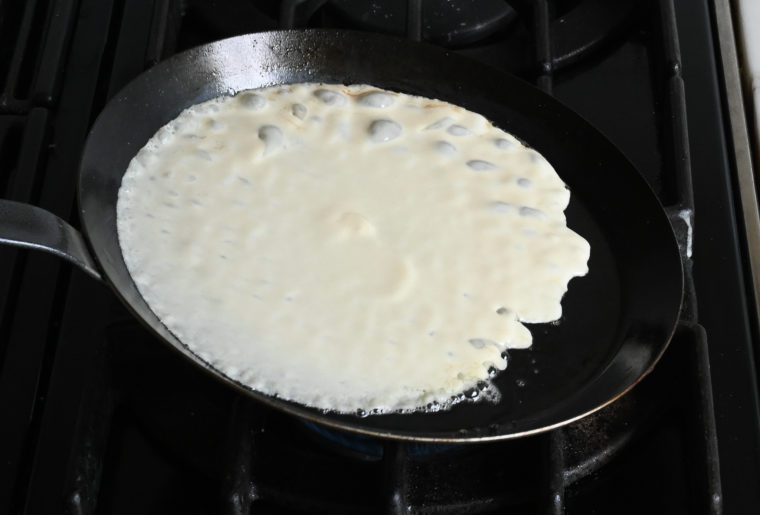
Keep turning the pan until the batter is evenly spread.
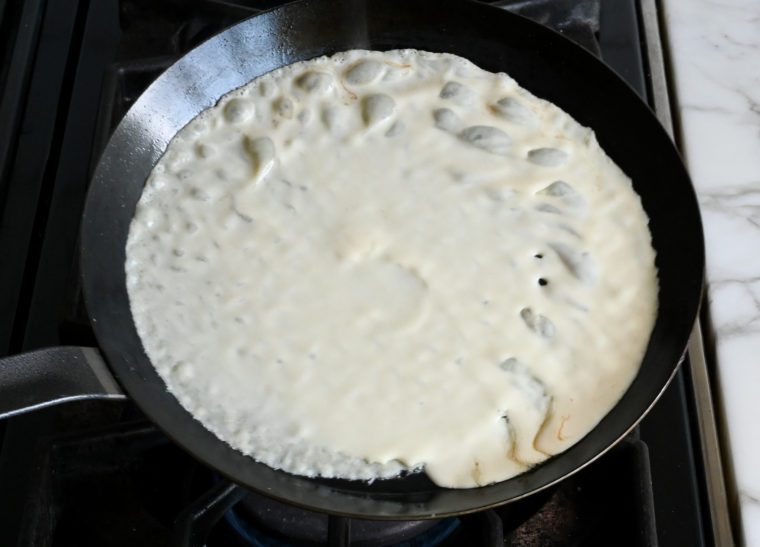
Cook for about 1 minute, until the top is set, the edges are dry, and the crepe is golden on the bottom.
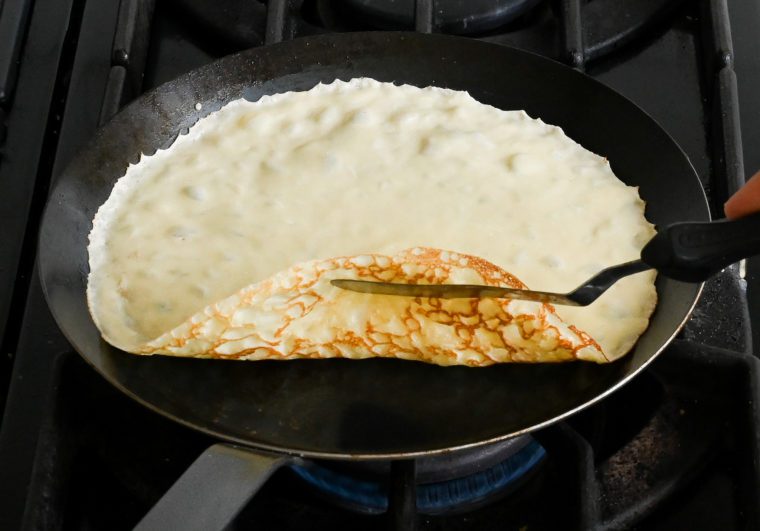
Lift the crepe with an offset spatula or butter knife, taking care not to scratch the pan with the utensil, and flip with your fingertips; cook the other side for about 20 seconds, or until slightly golden and spotted.
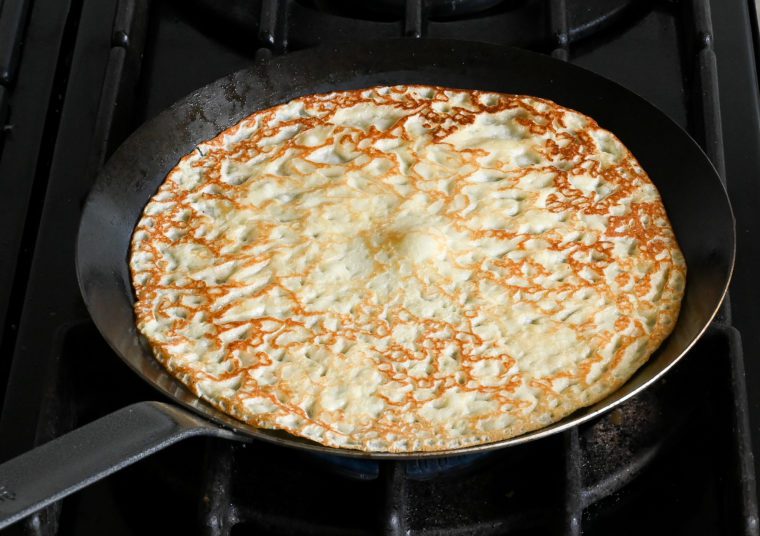
Transfer the cooked crepe to a plate. Repeat with the remaining batter, greasing the pan with a bit of butter each time and adjusting the heat as necessary. Place the cooked crepes in a stack on the plate. Cover with plastic wrap until ready to serve.
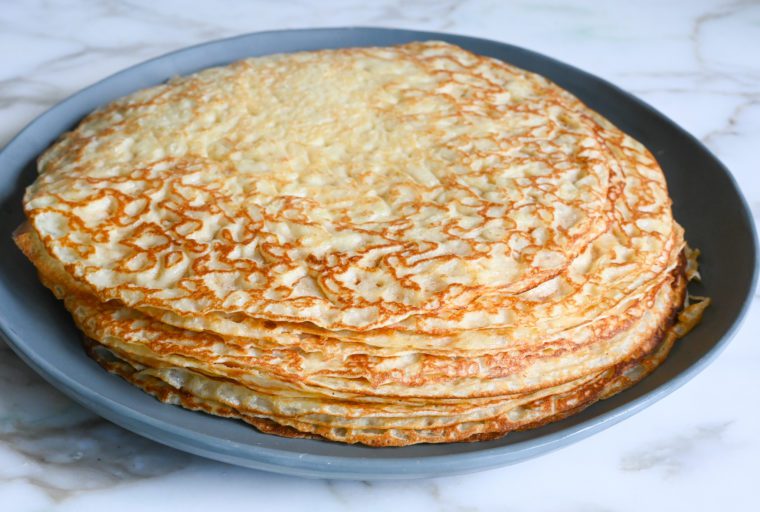
Frequently Asked Questions
The primary difference between French crepes and American pancakes is that crepe batter does not contain baking powder or baking soda, the leavening agents that make American pancakes puffy (see my favorite pancake recipe). Crepe batter is also made with a higher proportion of eggs and milk, which makes them a bit “eggier” and much thinner. Pancakes are typically only served with breakfast and brunch, whereas crêpes are enjoyed any time of day.
Absolutely! Crepes are wonderfully versatile in that they can be prepared in advance. Once cooked, allow them to cool to room temperature. Store the stacked crepes wrapped in plastic wrap or in a sealable plastic bag. You can refrigerate them for up to 3 days. When you’re ready to serve, gently reheat in a skillet over low heat.
Yes, crepes freeze nicely! To freeze, separate each crepe with wax or parchment paper, wrap tightly in plastic wrap, and freeze for up to 1 month. Thaw the stack overnight in the refrigerator before using, or just remove the crepes one by one as needed and thaw at room temperature before reheating.
The best way to reheat individual crepes is in a crepe pan or nonstick skillet. You can use a tiny bit of butter and heat over medium heat until warm and slightly crisp on the edges, about 30 seconds. To reheat a stack of crepes, wrap in aluminum foil and heat in a 350°F-oven until warmed through, 5 to 10 minutes.
To assemble savory crepes that need warming, start by spreading your chosen fillings over one half of each crepe. Then, fold the crepe in half to create a half-moon shape, and fold it once more into quarters. Continue this process with the remaining crepes. Next, heat a buttered skillet over medium heat and place the folded crepes in the skillet. Warm them until the fillings are heated thoroughly (ensuring any cheese is nicely melted) and the crepes gain a slight crispness on the outside.

Video Tutorial
You May Also Like
Crepes
Making traditional French crepes at home is easier than you think. Serve them up with your favorite sweet or savory fillings any time of day. Bon appétit!
Ingredients
- 2¼ cups whole or 2% milk
- 4 large eggs
- 2 tablespoons sugar
- 1 teaspoon vanilla extract
- ½ teaspoon salt
- 1½ cups all-purpose flour, spooned into measuring cup and leveled off
- 4 tablespoons butter, melted and slightly cooled, plus more for cooking the crepes
Instructions
- Place the milk, eggs, sugar, vanilla, and salt into a blender. Whiz for 5 to 10 seconds to blend until smooth. Remove the lid, add the flour, cover, and blend again until completely smooth, about 30 seconds. Remove the lid, pour in the melted butter, cover, and blend until combined, about 10 seconds more. Transfer the batter to a bowl or separate container and let it rest in the refrigerator for at least 30 minutes or up to 24 hours.
- Heat a crepe pan or 8 to 10-inch nonstick skillet (see note) over medium heat. Grease the pan lightly and evenly with butter. Pour about ¼ cup of crepe batter into the center of the pan (you can use a ¼-cup dry measuring cup to "ladle" the batter into the pan). Immediately lift the pan off the heat and swirl the batter so that it forms a thin, even circle on the bottom of the pan. Cook for about 1 minute, until the top is set, the edges are dry, and the crepe is golden on the bottom. Lift the crepe with an offset spatula or butter knife, taking care not to scratch the pan with the utensil, and flip with your fingertips; cook the other side for about 20 seconds, or until slightly golden and spotted. Transfer the cooked crepe to a plate. Repeat with the remaining batter, greasing the pan with a bit of butter each time and adjusting the heat as necessary. Place the cooked crepes in a stack on the plate. Cover with plastic wrap until ready to serve. (Note that the first crepe is rarely perfect; it "seasons" the pan so the remaining crepes are easy to cook, and it also tells you if the pan's temperature is right.)
- To serve: Warm the crepes using one of the methods below and fill with your favorite fillings. Roll the crepes or fold in half or into quarters, and top with your favorite toppings.
- Note: This recipe contains sugar and vanilla for a sweet version of a crepe. If you’d like to make savory crepes, reduce the sugar to one tablespoon, omit the vanilla extract, and add some fresh chives or other herbs if you like. A bit of finely grated Parmigiano Reggiano is good, too.
- Note: You can cook crepes in any 8 to 10-inch nonstick pan (the base of the pan should have the same diameter that you want for your crepes), but the ideal pan for making crepes is a traditional French crepe pan.
- Make-Ahead/Freezer-Friendly Instructions: Wrap the stacked crepes in plastic wrap and store in refrigerator for up to three days. To freeze, separate each crepe with wax or parchment paper, wrap tightly in plastic wrap, and freeze for up to 1 month. Thaw the stack overnight in the refrigerator before using, or just remove the crepes one by one as needed and thaw at room temperature before reheating.
- Reheating Instructions: The best way to reheat individual crepes is in a crepe pan or nonstick skillet. You can use a tiny bit of butter and heat over medium heat until warm and slightly crisp on the edges, about 30 seconds. To reheat a stack of crepes, wrap the crepes in aluminum foil and heat in a 350°F-oven until warmed through, 5 to 10 minutes.
Nutrition Information
Powered by ![]()
- Serving size: 1 crepe
- Calories: 127
- Fat: 7 g
- Saturated fat: 4 g
- Carbohydrates: 12 g
- Sugar: 3 g
- Fiber: 0 g
- Protein: 4 g
- Sodium: 106 mg
- Cholesterol: 61 mg
This website is written and produced for informational purposes only. I am not a certified nutritionist and the nutritional data on this site has not been evaluated or approved by a nutritionist or the Food and Drug Administration. Nutritional information is offered as a courtesy and should not be construed as a guarantee. The data is calculated through an online nutritional calculator, Edamam.com. Although I do my best to provide accurate nutritional information, these figures should be considered estimates only. Varying factors such as product types or brands purchased, natural fluctuations in fresh produce, and the way ingredients are processed change the effective nutritional information in any given recipe. Furthermore, different online calculators provide different results depending on their own nutrition fact sources and algorithms. To obtain the most accurate nutritional information in a given recipe, you should calculate the nutritional information with the actual ingredients used in your recipe, using your preferred nutrition calculator.

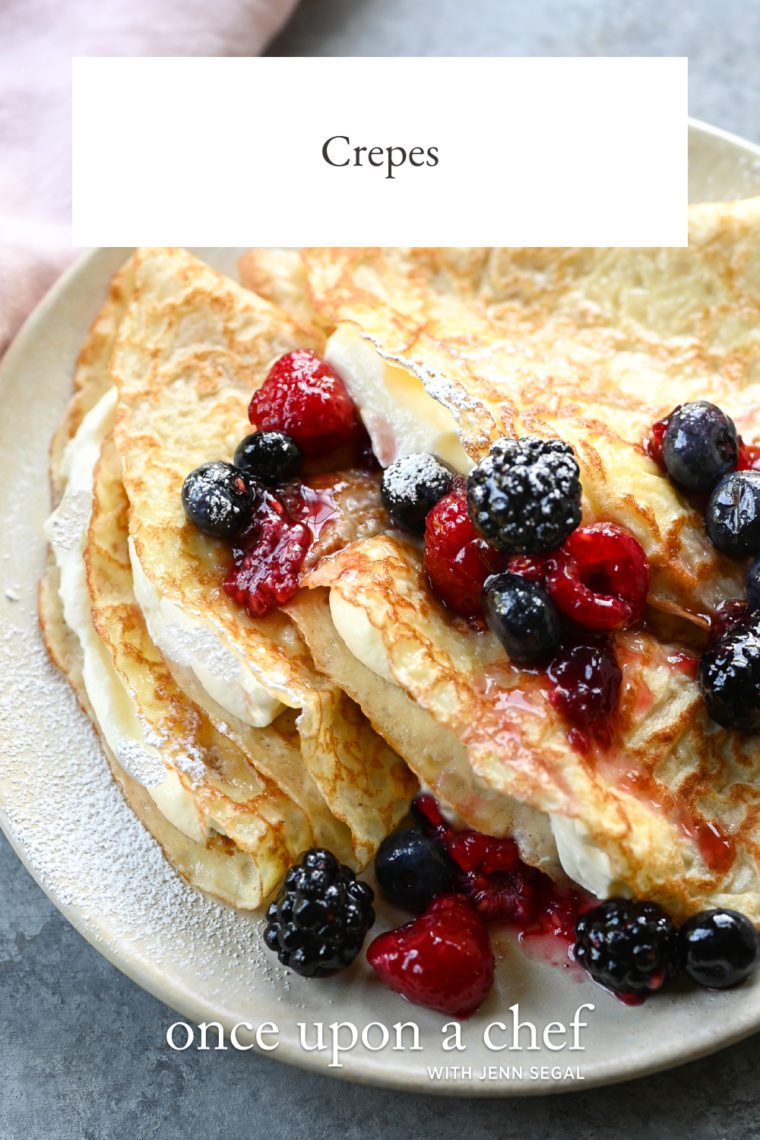




Perfect crepes! How many days will the batter be good in the fridge?
Glad you liked them! I think you can refrigerate the batter for 2 to 3 days. You can also freeze the cooked crepes.
I don’t have a crepe pan, just a regular one. The crepes still turned out fabulous- thin and crispy. I was surprised at how easy it was to make! Thanks for posting this recipe.
Can I substitute some buckwheat flour for AP for savory crepes?
Hi Steve, Buckwheat flour has a gritty texture so if you want to give it a try, I’d use half buckwheat flour and half AP flour. If you try it, I’d love to hear how the crepes turn out!
Can this recipe be cut in half? A dozen or more leftover crepes is a bit much for our household, now that the kids are grown.
Sure, Kim, that’s fine. Enjoy!